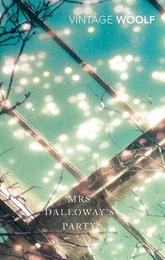
|
Mrs Dalloway's Party: A Short Story Sequence
Paperback / softback
Main Details
| Title |
Mrs Dalloway's Party: A Short Story Sequence
|
| Authors and Contributors |
By (author) Virginia Woolf
|
| Physical Properties |
| Format:Paperback / softback | | Pages:80 | | Dimensions(mm): Height 198,Width 129 |
|
| Category/Genre | Classic fiction (pre c 1945) |
|---|
| ISBN/Barcode |
9780099541325
|
| Classifications | Dewey:823.912 |
|---|
| Audience | |
|---|
|
Publishing Details |
| Publisher |
Vintage Publishing
|
| Imprint |
Vintage Classics
|
| Publication Date |
3 May 2012 |
| Publication Country |
United Kingdom
|
Description
Seven enchanting short stories all written around the theme of parties Written in the same period as Mrs Dalloway these seven short stories show the author's fascination with parties and with all the excitement, the fluctuations of mood and temper and the heightened emotions which surround these social occasions. Mrs Dalloway's Party is enchanting piece of work by one of our most acclaimed twentieth-century writers.
Author Biography
Virginia Woolf was born in London in 1882, the daughter of Sir Leslie Stephen, first editor of The Dictionary of National Biography. After his death in 1904 Virginia and her sister, the painter Vanessa Bell, moved to Bloomsbury and became the centre of 'The Bloomsbury Group'. This informal collective of artists and writers which included Lytton Strachey and Roger Fry, exerted a powerful influence over early twentieth-century British culture. In 1912 Virginia married Leonard Woolf, a writer and social reformer. Three years later, her first novel The Voyage Out was published, followed by Night and Day (1919) and Jacob's Room (1922). These first novels show the development of Virginia Woolf's distinctive and innovative narrative style. It was during this time that she and Leonard Woolf founded The Hogarth Press with the publication of the co-authored Two Stories in 1917, hand-printed in the dining room of their house in Surrey. Between 1925 and 1931 Virginia Woolf produced what are now regarded as her finest masterpieces, from Mrs Dalloway (1925) to the poetic and highly experimental novel The Waves (1931). She also maintained an astonishing output of literary criticism, short fiction, journalism and biography, including the playfully subversive Orlando (1928) and A Room of One's Own (1929) a passionate feminist essay. This intense creative productivity was often matched by periods of mental illness, from which she had suffered since her mother's death in 1895. On 28 March 1941, a few months before the publication of her final novel, Between the Acts, Virginia Woolf committed suicide.
ReviewsFull of insightful monologues about human frailty, these stories are a stand-alone delight worth investigating * Stylist * Mesmerising -- Val Hennessey * Daily Mail *
|